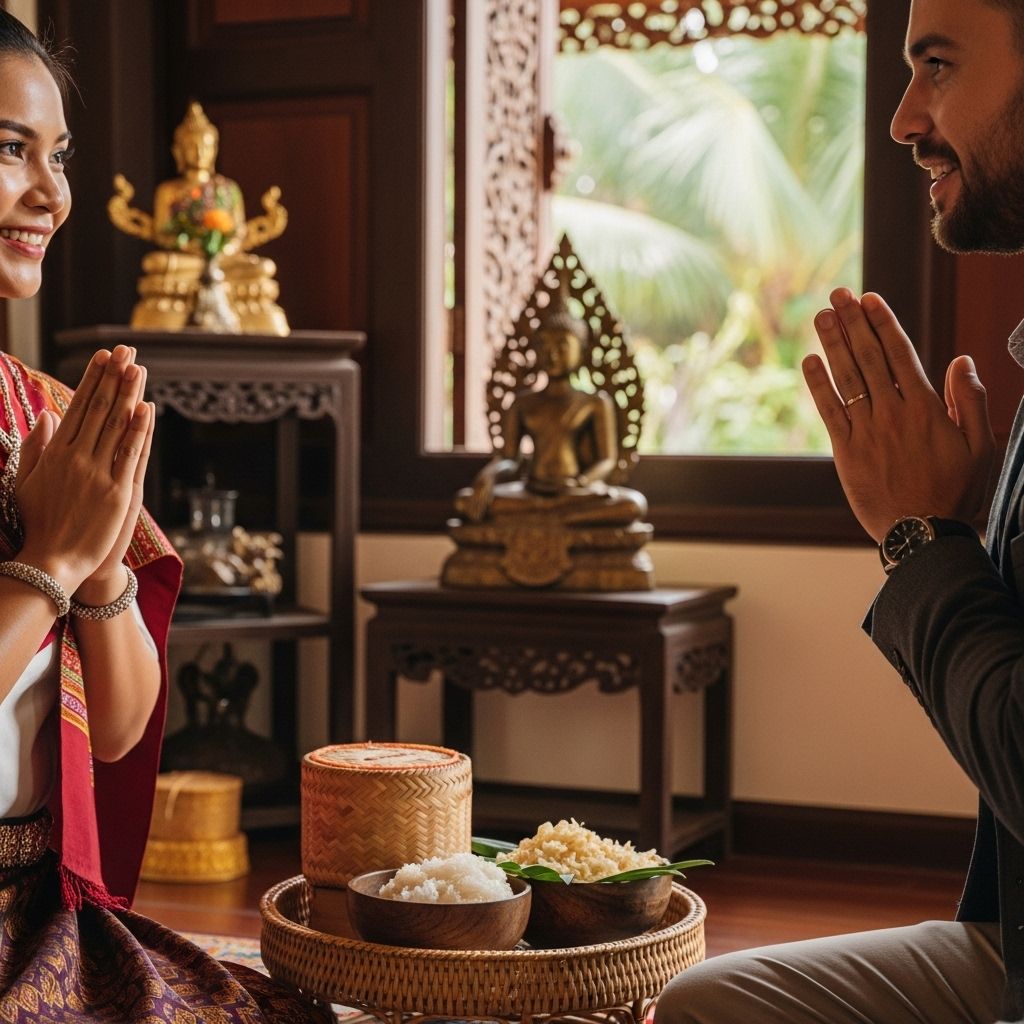Laos Greetings & Etiquette: Essential Guide for Visitors and Cultural Sensitivity
Discover the traditional Lao nop greeting, cultural dos and don’ts, and essential etiquette for a respectful and memorable visit to Laos.

The Significance of Greetings in Lao Culture
Greetings in Laos are more than just a formality—they are a crucial expression of respect, humility, and cultural identity. The traditional greeting, known as the nop, is a central part of daily life and social interaction. When you visit Laos, understanding and correctly performing these greetings can make a significant difference in how you are perceived and how warmly you are received by locals.
The Traditional Lao Greeting: The Nop
The nop is the most distinctive and meaningful gesture in Lao culture. It involves pressing your palms together in a prayer-like position, accompanied by a slight bow or inclination of the head, and a warm smile. The precise placement of your hands and the depth of your bow convey different levels of respect and social hierarchy.
How to Perform the Nop
- For Peers or Strangers: Place your hands together at chest level, with fingers pointing upwards and elbows close to your body.
- For Elders or Those of Higher Status: Raise your hands higher, ideally so your fingertips reach your nose, and bow your head slightly more deeply to show greater respect.
- For Monks or Very Respected Persons: Lower your head further, sometimes bringing your hands higher, and maintain a humble posture.
- For Children or Those of Lower Status: Hold your hands at chin level, showing a lesser degree of deference.
Common Greetings and Phrases in Lao Language
Accompanying the nop gesture, Laotians often say “sa bai dee” (ສະບາຍດີ), which means “hello” or “are you well?”. Variations include:
| Greeting | Meaning | Usage |
|---|---|---|
| Sa bai dee | Hello / Greetings | General greeting |
| Sa bai dee bor? | How are you? / Are you well? | Polite inquiry |
| Kin khao leo bor? | Have you eaten? | Friendly, casual greeting |
| Khop jai | Thank you | Expressing gratitude |
Smiling is an important part of Lao greetings, conveying warmth and friendliness. The usual response to “sa bai dee bor?” is simply “sa bai dee”.
Greetings Between Different Genders and Social Statuses
Men Greeting Men
Among men, the nop is most common, but it’s also acceptable to shake hands, especially between close friends or with foreigners. However, the handshake should be gentle and warm, not firm.
Women Greeting Women
Women typically use the nop gesture, with hands pressed together just below the chin, accompanied by a slight bow and a smile. Physical contact beyond the nop is rare.
Greetings Between Men and Women
Between genders, the nop is the only appropriate gesture—no handshakes or physical contact. This reflects the conservative nature of Lao society, where public displays of affection between men and women are not customary.
Greeting Elders and Monks
When greeting elders or monks, it’s respectful for the younger or lower-status person to initiate the nop and bow more deeply. The hands should be held higher, often touching the nose, and the bow should be more pronounced. Monks, as highly respected figures, may not return the gesture, but a respectful nop is always appreciated.
Etiquette and Cultural Norms for Foreign Visitors
Dos and Don’ts in Social Interactions
- Respect for Elders: Always show great respect to elders. Allow them to initiate conversation or gestures if they wish.
- Dress Conservatively: Wear modest, clean clothing, especially when visiting temples or rural areas.
- Avoid Physical Contact: Touching someone’s head is considered highly disrespectful, as it is seen as the most sacred part of the body. Similarly, pointing with your feet or touching others with your feet is offensive, as feet are considered the least sacred.
- Remove Shoes: Always remove your shoes before entering a Lao home or a temple.
- Use Polite Language: Addressing someone by their title (Mr., Mrs., Uncle, Aunt) before their name is respectful.
When to Use the Nop
The nop is appropriate for greetings, farewells, expressing thanks, and showing respect. However, it is not typically used for waitstaff, children, or in very casual situations.
The Role of Smiling in Lao Culture
Lao people are known for their gentle and polite demeanor, and smiling is a key part of communication. A smile often accompanies the nop and is used to show friendliness, humility, and to diffuse tension. Even in difficult situations, a smile is valued over confrontation.
Greeting Customs in Different Settings
In the Home
When visiting a Lao home, guests are expected to show respect and humility. Always greet the eldest person first with a nop and a smile. Wait to be invited before entering, and remove your shoes at the door.
In Temples
Temples (wats) are sacred places where decorum is especially important. Dress modestly, remove your shoes, and always greet monks with the highest level of nop. Avoid pointing your feet at Buddha images or monks.
In Business and Formal Settings
In professional or formal contexts, the nop is still the preferred greeting. Handshakes may be used with foreigners, but always wait for the Lao person to initiate physical contact. Business cards should be offered and received with both hands.
How Lao Greetings Differ From Neighboring Cultures
While the nop is similar to the Thai wai, there are subtle differences in hand placement and social expectations. Lao greetings tend to be less formal and more relaxed than in Thailand, and physical contact is even less common, especially between genders.
Frequently Asked Questions (FAQs)
Q: Is it acceptable for a foreigner to use the nop greeting?
A: Yes, foreigners are encouraged to use the nop when greeting Laotians. It is seen as a sign of respect and cultural understanding.
Q: What should I do if I’m not sure about someone’s social status?
A: If in doubt, use a moderate nop with your hands at chest or mouth level and a slight bow. Observing how others greet each other can also be helpful.
Q: Can I shake hands with Lao people?
A: Handshakes are acceptable, especially among men or with foreigners, but the nop is always safe and respectful. Avoid initiating physical contact with the opposite gender.
Q: Are there any gestures or actions I should avoid?
A: Avoid touching anyone’s head, pointing with your feet, or showing public displays of affection. Always dress modestly, especially in religious or rural settings.
Q: How important is smiling during greetings?
A: Smiling is very important and is seen as a sign of friendliness and humility. Always try to smile when greeting someone, even if you are unsure of the correct gesture.
Conclusion: Embracing Lao Greetings and Etiquette
Mastering the nop and understanding Lao greetings and social etiquette will enrich your travel experience in Laos and help you connect meaningfully with local people. By showing respect for Lao customs, dressing appropriately, and greeting others with a smile, you demonstrate cultural sensitivity and earn the goodwill of your hosts. Whether you are visiting for business, tourism, or cultural exchange, these simple gestures can open doors and create lasting positive impressions.
Read full bio of medha deb












